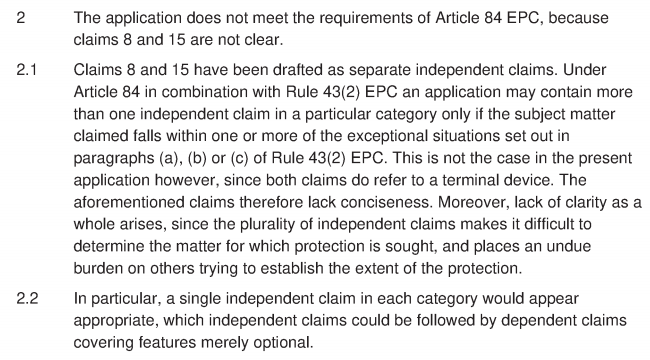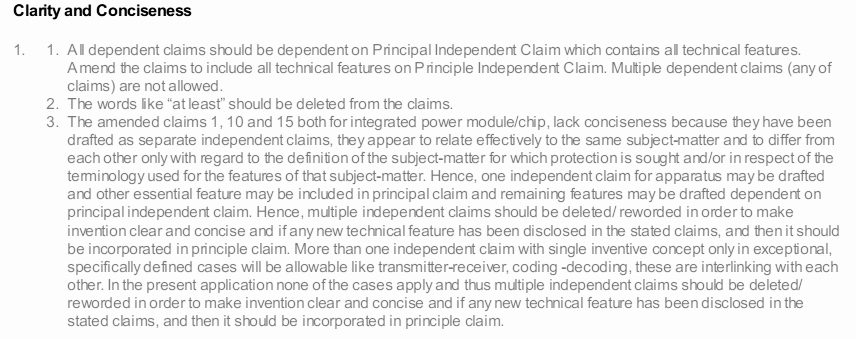发布时间: 2024-02-18
作者:韩冬 专利工程师
引言:
我们在处理欧洲专利申请时,经常会遇到所谓“一类一独权”的审查意见,即,如果相同类别(产品、方法、装置或用途)中存在多于一个的独立权利要求,且这些独立权利要求并不属于特定的例外情况,则会导致权利要求书不简洁而被审查员反驳。此外,印度专利局也会签发类似的审查意见。在此,笔者试结合实务分享处理EP专利申请和IN专利申请中“一类一独权”问题的一点心得。
欧洲专利申请
在欧洲专利实务中,审查员通常使用《欧洲专利公约》第84条有关权利要求书不简洁(concise)的规定结合《欧洲专利公约实施细则》第43(2)条的三种例外情况来评述“一类一独权”问题,这种审查意见例如如下所示:

这里所涉及的具体法条如下:
《欧洲专利公约》第84条
Claims:
The claims shall define the matter for which protection is sought. They shall be clear and concise and be supported by the description.
《欧洲专利公约实施细则》第43(2)条
Rule 43 Form and content of claims:
(2) Without prejudice to Article 82, a European patent application may contain more than one independent claim in the same category (product, process, apparatus or use) only if the subject-matter of the application involves one of the following:
(a) a plurality of interrelated products,
(b) different uses of a product or apparatus,
(c) alternative solutions to a particular problem, where it is inappropriate to cover these alternatives by a single claim.
可见,《欧洲专利公约》第84条规定了权利要求书应当限定要求保护的主题,且权利要求书应当是清楚和简洁的。
《欧洲专利公约实施细则》第43(2)条中规定了可以在相同类别(产品、方法、装置或用途)中包含多于一个的独立权利要求的三种例外情况:1、相互关联的产品;2、产品或装置的不同应用;3、针对特定问题的可替换方案,且这些可替换方案不适合通过单个权利要求来覆盖。
此外,《欧洲审查指南》的F部分(The European Patent Application)第IV章(Claims (Art. 84 and formal requirements))第3.2节(Kinds of claim-Number of independent claims)中给出了上述三种例外情况的进一步解释。
第一种例外情况(Rule 43(2)(a)),即,多个相互关联的产品,例如可以是插头和插座、发送器和接收器、中间体和最终化学产品、基因-基因构建体-宿主-蛋白质-药物。“相互关联”一词被解释为“相互补充或共同作用的不同对象”。
第二种例外情况(Rule 43(2)(b)),即,产品或装置的多种不同发明用途,例如可以是(1)在已知第一种医疗用途时,涉及进一步医疗用途的多个独立权利要求,(2)涉及化合物 X 的多种用途的多个独立权利要求,例如化合物X用于强化头发的独立权利要求和化合物X用于促进头发生长的独立权利要求。
第三种例外情况(Rule 43(2)(c)),即,特定问题的替代方案,例如可以是一组化合物,或者制造此类化合物的两种或两种以上的工艺。其中,“替代方案”一词可解释为“不同的或相互排斥的可能性”。
《欧洲审查指南》中还给出了允许的权利要求的具体示例如下:
示例1:
第一个独立权利要求:一种数据发送方法,用于在连接到总线的多个设备之间发送数据包。
第二个独立权利要求:一种数据接收方法,用于在连接到总线的多个设备之间接收数据包。
这两个独立权利要求属于Rule 43(2)(a)规定的第一种例外情况,故被允许。
示例2:
第一个独立权利要求:操作数据处理系统的方法,包括:步骤A、B、......。
第二个独立权利要求:一种数据处理装置/系统,包括:用于执行所述方法的装置。
第三个独立权利要求:一种计算机程序[产品],适于执行所述方法。
第四个独立权利要求:一种计算机可读存储介质/数据载体,包括所述程序。
这四个独立权利要求也属于Rule 43(2)(a)规定的第一种例外情况,故被允许。
需要注意的是,当几个独立权利要求涉及的是没有足够区别的等同实施例时,也就是说,如果这几个独立权利要求保护的内容基本一致(例如,一个独立权利要求保护一种适于执行所述方法的计算机程序,可选地所述计算机程序承载在电力载波信号上,另一个独立权利要求保护一种计算机程序,包含适于执行方法步骤 A、B......的软件代码),则细则第43(2)条规定的例外情况通常并不适用。
此外,《欧洲专利公约实施细则》第62(a)条进一步规定当专利申请不符合上述细则第43(2)条的规定时,欧洲专利局的处理方式:
R. 62a Applications containing a plurality of independent claims
(1) If the European Patent Office considers that the claims as filed do not comply with Rule 43, paragraph 2, it shall invite the applicant to indicate, within a period of two months, the claims complying with Rule 43, paragraph 2, on the basis of which the search is to be carried out. If the applicant fails to provide such an indication in due time, the search shall be carried out on the basis of the first claim in each category.
(2) The Examining Division shall invite the applicant to restrict the claims to the subject-matter searched unless it finds that the objection under paragraph1 was not justified.
上述条款可以被理解为,如果欧洲专利局发现在一件专利申请中在相同类别中含有超过一项的独立权利要求,且《欧洲专利公约实施细则》第43(2)条的例外情形都不适用时,欧洲专利局将不会对所有独立权利要求做检索,而是要求申请人在2个月的期限内指出要被检索的独立权利要求,或是解释其如何适用于上述的例外情形。否则,欧洲专利局将会只检索每一类别中的第一项独立权利要求,而审查部门也会要求申请人将权利要求限制到已被检索的权利要求。也就是说,将来只会基于已被检索的权利要求而进行进一步的审查,这对后续的答复会造成不利的影响,因此我们在撰写EP案独权时需要谨慎考虑上述《欧洲专利公约实施细则》第43(2)条的规定。
针对“一类一独权”这样的审查意见,如果我们判断多个独立权利要求确实属于同一类别且不符合细则第43(2)条规定的任一种例外情形,则可以保留相对比较有价值或者客户更需要的一项独立权利要求并删除其他独立权利要求;或者,我们也可以尝试争辩同一类别下的多个独立权利要求之间具有“强关联”,例如属于相互关联的多个产品、或者同一产品的不同用途或者解决同一问题且不宜在一个独立权利要求中体现的方案。另外,我们还可以对独立权利要求的特征进行调整,使同一类别下的多个独立权利要求之间的特征更为关联,以尽可能贴近细则第43(2)条规定的例外情形。
印度专利申请
在印度专利审查过程中,审查员通常使用印度《专利法》第10(5)条有关权利要求书不清楚和不简洁的规定来反驳相同主题的多个独立权利要求,这类似于上述EP专利申请的“一类一独权”问题。
IN专利申请的情况相对复杂,因为不同审查员对于上述问题的审查尺度并不相同,部分审查员甚至认为权利要求书中针对一个发明构思只能有一个独权,即主要独立权利要求(principal independent claim),其他独权应修改为引用该独权的形式。此类问题常被IN审查员归类为“Clarity and Conciseness”,这种审查意见例如如下所示:

这里所涉及的具体法条如下:
印度《专利法》第10(5)条
(5) The claim or claims of a complete specification shall relate to a single invention, or to a group of inventions linked so as to form a single inventive concept, shall be clear and succinct and shall be fairly based on the matter disclosed in the specification.
此外,在《专利实践和程序指南(Manual of Patent Practice and Procedure)》, The Patent Office, India, 2019中记载有如下相关内容:
Structure of Claims
r) The first claim is always an independent claim also known as ‘Principal Claim’. It should clearly define the essential features of the embodiment(s) of the process/product that constitutes the invention. The claim should be properly characterized with respect to the ‘prior art’, defining all the technical features essential to the invention or inventive concept. The claim should bring out sufficient details of interrelationship and/or operation to establish that the invention achieves the intended objectives.
s) There may be more than one independent claim in a single application if the claims fall under a single inventive concept. While there is no restriction as to the number of claims, including independent claims, it is advisable to limit the number of claims, as well as the number of independent claims in a single.
其中,在有关单一性的规定中,也隐含了“一类一独权”的相关内容。
Unity of Invention
1) The Claims of a Specification shall relate to a single inventive concept. In case, an application comprises a plurality of inventive concepts the examiner refers to the same in his report. The application may be divided in order to meet the objection of plurality of distinct inventions.
2) The determination whether a group of inventions is so linked as to form a single inventive concept shall be made without regard to whether the inventions are claimed in separate claims or as alternatives within a single claim.
3) Unity of invention between process and apparatus or means requires that the apparatus or means have been specifically designed for carrying out the process.
4) Independent claims of different categories may relate to a single inventive concept and may be allowed in one application, when they are linked to form a single inventive concept and are supported by the description.
For example:
a) Claims for a product and process specially adapted for manufacture of the product.
b) Claims for a process and apparatus or means specifically designed for carrying out the process.
c) A mould for casting an article, a method of making that mould, a process of casting the article by using the said mould will constitute a single invention.
d) A locking system containing plug and socket wherein separate independent claims for a plug and socket may constitute a single inventive concept.
e) A broadcasting system comprising transmitter and receiver.
f) If an invention relates to a new type of spray bottle, claims may be directed to the spray bottle itself (a product) and a method of making the spray bottle (a process).
g) In case of a genetically modified Gene Sequence/Amino Acid Sequence claims may be directed to a Gene sequence/ Amino Acid sequence, a method of expressing the sequence, an antibody against that protein/sequence, a kit containing such antibody/ sequence.
h) In case of a drug or pharmaceutical product, claims may be directed to a drug or pharmaceutical product, a process of making the product, a composition containing the drug.
可见,IN案中允许多项独立权利要求的存在,也允许插头/插座、发送器和接收器这种同一类别的多项独立权利要求的存在。
针对IN专利申请中“一类一独权”的审查意见,笔者主要总结了常用的答复策略如下:
1. 将部分独权修改为"application claims"的形式。
对于CRI(与计算机相关发明)申请,"application claims"被非正式地用来指那些被改写为引用该申请的主要独立权利要求(principal independent claim,其定义请参见上述《专利实践和程序指南》的内容)或另一独立权利要求的独立权利要求。例如,在CRI申请中,装置权利要求可以被撰写为引用方法权利要求。同理,对于相互关联的装置权利要求,可以改写为引用关系。例如,权利要求书中包括主题A"An integrated power module"的独立权利要求和主题B"An interleaved parallel circuit"的独立权利要求,主题A和主题B之间为包含关系,则可以将主题A修改为"An integrated power module, comprising the interleaved parallel circuit as claimed in claim…"。
2. 在独权中补入与其他独权相关联的表述,即,使得多个独立权利要求具有“强关联”。例如,权利要求书中包括主题A"An integrated power module"的独立权利要求和主题B"An interleaved parallel circuit"的独立权利要求,主题A和主题B之间为包含关系,则可以将主题A修改为"An integrated power module, provided with an interleaved parallel circuit..."。
3. 针对相互关联的产品或方法(比如接头/接口、模块/装置等)、产品和装置的不同应用(比如不同医学领域的应用)、无法相互结合的两侧交互的技术方案(比如接收端/发送端、终端/基站等),通常可以采用以下答复策略:尽管独立权利要求 A 和 B 无疑具有单一的创造性概念,但它们应被独立保留,以确保免受可能发生的两种不同类型的潜在侵权行为的侵害(Although undoubtedly claims A and B have a single inventive concept but they are retained independently to ensure protection from two varying types of potential infringement that may occur)。在此,我们可以在意见陈述书中引用案例"Further, the Applicant submits that several cases with multiple independent method/device claims have been granted in the past by Indian patent office (such as for example 3940/KOLNP/2015)."以加强陈述力度。
4. 对于同时包括虚拟装置和实体装置的情况,IN审查员的态度通常比较坚决,对此我们可以考虑删除虚拟装置和实体装置其中之一。
在了解上述关于“一类一独权”的相关法条和规定后,我们可以针对性地根据法条答复审查意见,并可以在撰写阶段尽量避免这种问题的产生。
以上只是个人在工作中总结的主观内容,如有谬误,欢迎大家批评指正。